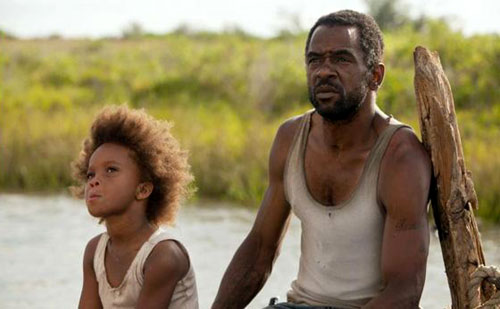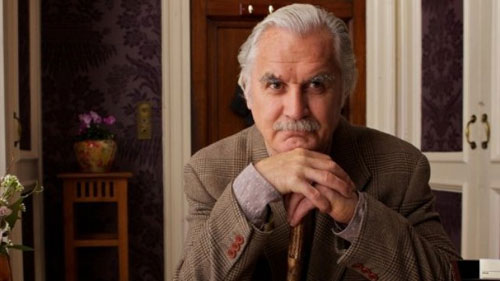|
I did not see Benh Zeitlin's Beasts of the Southern Wild during its summer 2012 theatrical release, and caught up with it only after its release on DVD, which was also after it was nominated for Best Picture and three other Academy Awards. Few Best Picture Oscar nominees have come so completely out of left field: a low-budget picture whose director and two leading actors are all newcomers to feature films, and whose protagonist is six years old.
But then again, nothing about Beasts of the Southern Wild is at all usual. Given the film's strong strain of magic realism, it is hard to think of any movie that resembles it. Terrence Malick's films come close in their visual impressionism, but they lack the rich specificity of Beasts. I also found myself thinking of the films of Albert Lamorisse (White Mane, The Red Balloon), but Beasts, despite the sorrows it depicts, is both less precious and more hopeful.
Beasts is narrated by Hushpuppy (Quvenzhane Wallis), one of the youngest residents of an isolated Louisiana bayou community nicknamed "The Bathtub." She lives in a trailer with her father, Wink (Dwight Henry); they each keep to their own side, with the kitchen as common ground. Hushpuppy's mother has left for parts unknown, although a woman who may or may not be Hushpuppy's mother appears late in the story.
 |
Aided by co-screenwriter Lucy Alibar and cinematographer Ben Richardson, Zeitlin does a masterful job of presenting The Bathtub and its natives through the eyes of a girl of six—an age at which magic realism is pretty much the normal state of the world. The audience is left to decipher which parts of what Hushpuppy sees occur exactly as she sees them. This is a given when the threat of Hurricane Katrina seems no more or less real to Hushpuppy as the threat of aurochs—giant prehistoric creatures who, according to her teacher, have been freed by the melting of the Polar Ice Cap and are on the march toward Louisiana.
However, three things are obvious. The first is that Hushpuppy, Wink and their neighbors are in a perilous situation. The second is that Wink is not well. At the beginning of the film he is gone much of the time, leaving Hushpuppy to fend for herself. When he is present, he yells at her. He slaps her, she punches him in the chest, and he is the one who falls over.
The third is that Wink and Hushpuppy, despite their fraught relationship, love each other very much. We see that Wink is rough with Hushpuppy because they live in a rough world, and Wink wants her to be as ready as possible when he is no longer there. One of the most compelling scenes is at a crab feast. Wink, enraged at Hushpuppy's tentative picking at a crab, stands up and orders her: "BEAST IT! BEAST IT! BEAST IT!" The crowd picks up the chant, simultaneously chiding Hushpuppy, encouraging her, and initiating her into the community.
Beasts of the Southern Wild, as Keats might have said, has "negative capability." Zeitlin and Alibar hurl us unprepared into the world of Hushpuppy and The Bathtub, showing us its singular realities through the eyes of a little girl who has never known anything else. They don't allow us our usual, comforting certainties to interpret it. For me, it took about an hour into the ninety-minute film before I really saw what Zeitlin and Alibar were trying to show me. And that was a moving epiphany indeed.
Beasts works on several levels. It is a coming-of-age story, an odyssey, a celebration of and elegy for a dying way of life. The Bathtub was already a shrinking community when Hurricane Katrina hit, Zeitlin tells us; the storm merely accelerated the process. But the people are still there, people who love their way of life and are determined to preserve it no matter what.
Wallis, the daughter of a truck driver and a schoolteacher from Houma, La., and Henry, a New Orleans baker, are essential to the film's impact. Wallis is an uncommonly assured child actress, but that alone would not have won her the Oscar nomination she received. What did were the two scenes toward the end in which Hushpuppy looks into her father's eyes—the first time angrily, the second tearfully. There are adult actresses, renowned ones, who have never reached the level of intensity Wallis achieves in those scenes.
Graced with an atmospheric music score by Zeitlin and Dan Romer, Beasts of the Southern Wild takes us into a world known to few, and makes it ours.
The same can be said for the new British film Quartet, though it can't claim the same level of originality as Beasts. Like Beasts, Quartet boasts a director making his debut: Dustin Hoffman, taking the helm of a feature film for the first time at age seventy-five. As more than one late-night comedian has opined, the kid has a future ahead of him.
Ronald Harwood wrote the screenplay for Quartet from his own play. The story is set in the fictional Beecham House, a luxurious but financially strapped home for retired musicians. Cedric (Michael Gambon), a flamboyant and autocratic former opera director, is busy rehearsing the residents for Beecham House's annual gala, which is always held on Oct. 10, Verdi's birthday. However, the heat is on this year: the gala is the home's major source of revenue, and poor ticket sales will force its closure.
Salvation seems at hand when Jean (Maggie Smith), a world-famous diva, moves into the home. Decades earlier, Jean made a legendary recording of Rigoletto with Reggie (Tom Courtenay), Wilf (Billy Connolly), and Cissy (Pauline Collins), all longtime residents of the home. Cedric commands Reggie, Wilf, and Cissy to persuade Jean to sing the Quartet from Rigoletto at the gala. "We could charge Covent Garden prices!" one of Beecham House's board members declares.
However, there are several impediments to this plan. First, Jean is painfully aware that her voice has faded, and has vowed never to sing in public again. Second, Jean and Reggie used to be married, and their breakup was unpleasant in much the same way the London Blitz was. Third, the health of Wilf and Cissy is uncertain at best; Wilf has had several strokes, and Alzheimer's chips away at Cissy's memory a little more every day.
Frankly, there isn't much to the story of Quartet. Most of the conflicts are easily resolved, and the movie ends on an upbeat note (pardon the pun). But two factors make it worth seeing. The first, of course, is the cast, a resplendent testimonial to the glories of British Rep. While everyone is excellent, I particularly liked Connolly, who brings to the character of Wilf a warmth and humanity that transcends the role's randy-old-man clichés.
 |
Second and more importantly, Quartet gives us a privileged glimpse into the lives of professional musicians—lives familiar to many readers of Scene4, but not to most of the moviegoing public. The singers, conductors, and instrumentalists in Quartet may have reached the end of their careers, but music still permeates and informs their lives, and the practice of music is ingrained in them. You cannot walk six steps inside Beecham House or on its grounds without encountering a string quartet or choir of madrigal singers. At times Quartet resembles a particularly posh, geriatric version of Tanglewood or Interlochen. That is all to the good, because it portrays people who remain students of great music throughout their lives. Hoffman and Harwood never let us forget that these characters, first and foremost, are artists. And artists they remain, even as a hush falls over them when one more of their number is taken away in an ambulance.
Lurking in the background of Quartet, and taking their bows as their turns come, are such notable British character actors as David Ryall and Andrew Sachs, as well as such brilliant musical figures as John Georgiadis and Dame Gwyneth Jones. The final scene of Quartet is touching, but nothing compared with the closing credits, which show the various cast members in their prime. If you aren't teary-eyed by the time you get to the portraits of the youthful Smith, Courtenay, Connolly and Collins, you're a certifiable hardcase.
Don't worry, Downton Abbey fans: Smith gets to fire off a Violet Crawley-style putdown or two. Arriving at Beecham House, she gazes sourly at a portrait of the home's namesake—the great conductor Sir Thomas Beecham—and notes that Beecham's father made a fortune manufacturing laxatives.
"Considering the circumstances," she says, "it seems thoroughly appropriate to name the place after him."
|